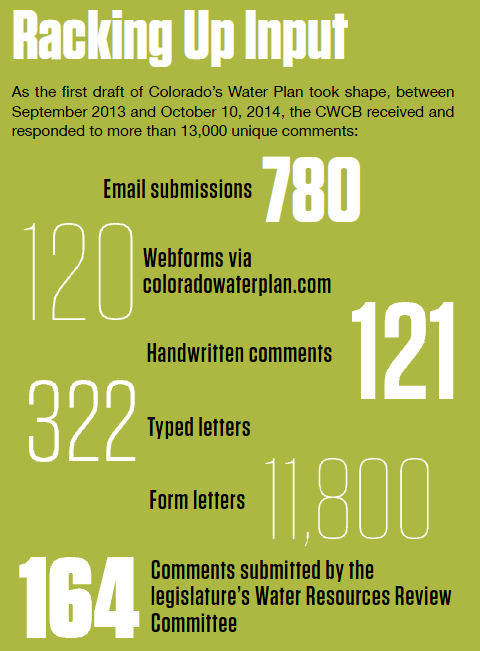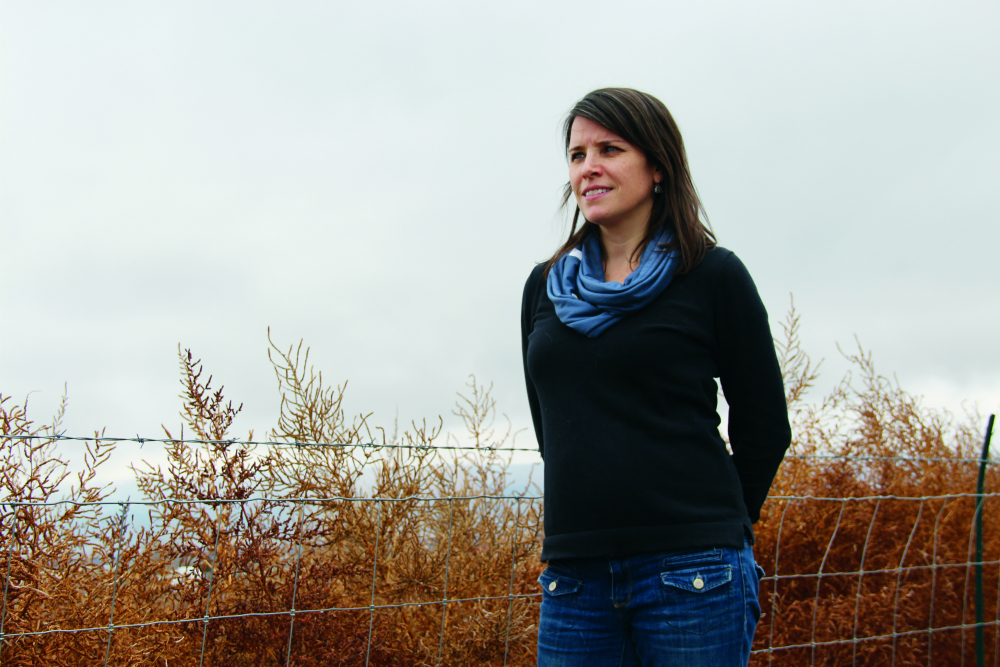Colorado’s Water Plan is touted as a democratic, self-actualized document produced “by Coloradans, for Coloradans.” That ideal, of course, can only be reached with one key ingredient: Coloradans. Widespread participation ought to ensure the many different perspectives about what should—or should not—be included in the new state water plan are represented. Not only did producing the first draft of Colorado’s Water Plan rely on the work of many existing stakeholders, but public input, say the plan’s authors, has been and will remain essential to refining a water plan that reflects Colorado residents’ many values.
Education and outreach efforts leading up to the first draft of Colorado’s Water Plan have been extensive to date. Some go back as far as 2005, before the plan was even conceived, when official mechanisms like the Public Education, Participation, and Outreach workgroup (PEPO) of the Interbasin Compact Committee were established solely to foster public engagement around the work of the state’s basin roundtables. Other efforts have been more recent, as the plan has moved—and continues moving—from conception to draft phase to finalization.
Public input, say the plan’s authors, has been and will remain essential to refining a water plan that reflects Colorado residents’ many values.
The CWCB, the nine basin roundtables, the state legislature’s interim Water Resources Review Committee, the Colorado Foundation for Water Education, and a consortium of state agencies, nongovernmental organizations, universities, and regional and local entities have worked to inform citizens about how they could most effectively express their opinions about the plan. Given that it is notoriously difficult to infiltrate busy lives and spark participation among average citizens, the primary focus of outreach efforts began with key constituent and stakeholder groups, policy makers, media, roundtable members themselves, the broader water community, and, finally, the general public.
“Getting the word out about the BIPs and Colorado’s Water Plan couldn’t have happened without all of the hard work and involvement at the grassroots level,” says Kate McIntire, education and public engagement coordinator for the CWCB, of the work that took place on multiple fronts, whether by the roundtables, PEPO group or other organizations.
To date, the CWCB alone has met with more than 100 organizations, agencies and partners to solicit input. In its first 12 months, the coloradowaterplan.com website’s page views climbed to 18,500. As of October 2014, when the public comment period closed for the plan’s first draft, more than 13,000 individual comments on the plan had been received by the CWCB, whether delivered via the website, by mail or email, or verbally at a meeting or hearing. Every comment was acknowledged and received a response.

The roundtables, too, received hundreds of comments as they developed their Basin Implementation Plans. Using local newspapers, websites, social media, radio, videos, postcards and fliers, and email lists, the roundtables worked to reach a wide audience and encourage attendance at meetings.
Numerous interest groups rallied the members of their organizations and communities to submit input. Business leaders from Protect the Flows, a coalition of 1,000 businesses whose tagline reads “The Business Voice of the Colorado River,” testified at legislative hearings held during summer 2014 and later at CWCB board meetings. “That’s a huge commitment for a businessperson,” says Molly Mugglestone, Protect the Flows co-director. “But we’re seeing that they really do have passion for this and they really do want this water plan draft to reflect their values.”
Those hearings conducted by the state legislative interim Water Resources Review Committee on the water plan during summer 2014 also reached people who might not otherwise have been heard. Senate Bill 115 directed legislators on the committee to travel the state basin by basin soliciting public comment. “The intent was to give concerned citizens not necessarily directly involved a greater voice,” says former state Rep. Randy Fischer. Many of the meetings were well attended and resulted in pages of public comments. But others lacked strong attendance. “Despite our best efforts, my sense is the general public is underrepresented in the process,” Fischer says.
That statement might relate to one criticism of the plan’s public input process that holding meetings, including most CWCB board meetings as well as some of the S.B. 115 hearings and roundtable engagement meetings, during the workday is inherently exclusive. “Are you really going to get someone who isn’t paid to work on water, or retired, to come out to these public meetings?” asks Theresa Conley, water advocate for Conservation Colorado. At the same time, she acknowledges the CWCB’s effort to create different forums to get people involved, including the website and other electronic communication, and believes some of the public’s lack of attendance is just “the nature of the beast” of engaging the public on a technical issue. Conservation Colorado built awareness and participation among its members through blogs, social media alerts, and water-focused events. Still, Conley says, “It’s a hard process to break into. We certainly had a lot of written public comments, but I have seen how difficult it is for some people to speak at meetings and to feel confident and competent with the process.”
Despite the challenges, there is optimism that even more of the public will become involved now that the draft water plan has been submitted. “I think there will be a lot more debate among concerned citizens,” says Fischer. “It’ll really give people something to react to.” Mike Gibson, chair of the Rio Grande Basin Roundtable, expressed similar sentiments: “There may be greater participation when individuals recognize that the anticipated changes…may impact their lifestyles and/or pocket book.”That statement might relate to one criticism of the plan’s public input process that holding meetings, including most CWCB board meetings as well as some of the S.B. 115 hearings and roundtable engagement meetings, during the workday is inherently exclusive. “Are you really going to get someone who isn’t paid to work on water, or retired, to come out to these public meetings?” asks Theresa Conley, water advocate for Conservation Colorado. At the same time, she acknowledges the CWCB’s effort to create different forums to get people involved, including the website and other electronic communication, and believes some of the public’s lack of attendance is just “the nature of the beast” of engaging the public on a technical issue. Conservation Colorado built awareness and participation among its members through blogs, social media alerts, and water-focused events. Still, Conley says, “It’s a hard process to break into. We certainly had a lot of written public comments, but I have seen how difficult it is for some people to speak at meetings and to feel confident and competent with the process.”
In the water plan, the CWCB suggests creation of a grant fund to expand education and outreach efforts well beyond December 2015, when the plan’s first iteration becomes final. After all, without a citizenry that understands and values water, it will be that much harder to build support for the plan’s implementation, yet water education is notoriously under-funded. “You have the infrastructure of educators and communications specialists who are ready and willing to go out and educate the masses. They don’t necessarily have the resources to do it,” says Kristin Maharg, director of programs at the Colorado Foundation for Water Education, who contributed to a section of the water plan on education and outreach. “If we could say at the state level, ‘this is a priority, here is a grant fund to help you do it,’ I think that is going to initiate a series of activities past 2015. This is just the beginning.”


 Print
Print